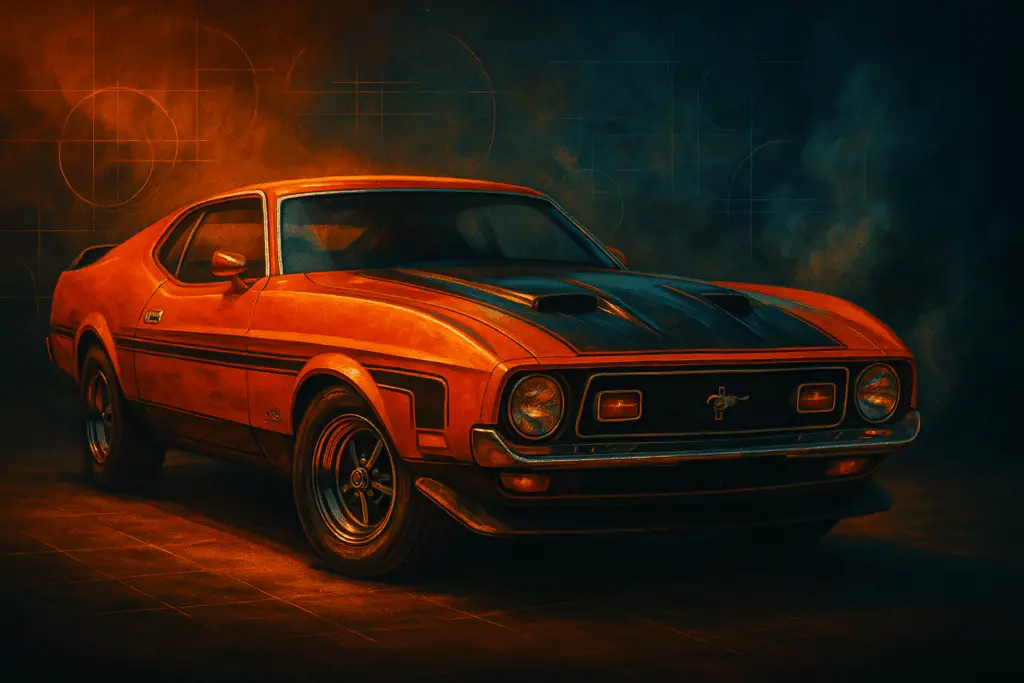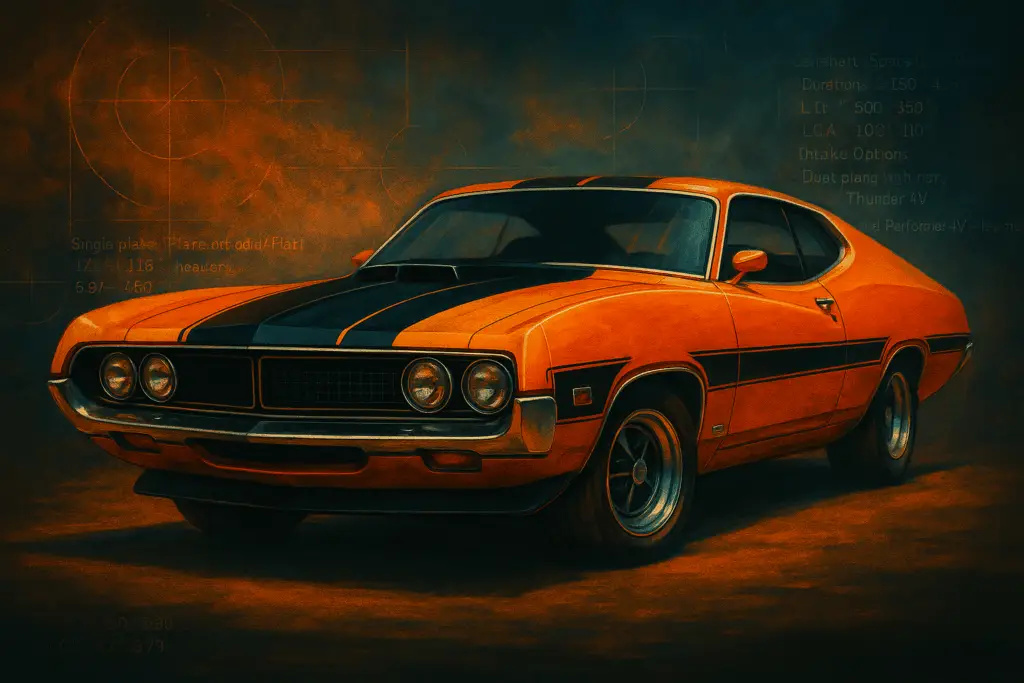The 351 Cleveland is famous for its airflow, canted-valve architecture, and the kind of high-RPM character you normally only find in big-block race engines. But the Cleveland also responds differently than the Windsor and other small blocks — cam timing, compression ratio, header size, and intake selection all matter more than they do on most Ford engines.
If you’re planning a 351C build, this guide breaks down the three most common combinations:
- Street Torque (2V or Aussie 2V heads)
- Street/Strip (U.S. 4V closed or open chamber)
- Boss-Style / Track-Leaning (4V closed chamber or aftermarket aluminum)
Each build includes detailed specs for camshafts, compression ratios, headers, gear ratios, and supporting mods.

1. STREET TORQUE BUILD
(2V or Australian Closed-Chamber 2V Heads)
Best For:
Daily drivers, cruisers, Broncos, F-150s, and anything that needs real-world torque and good manners.
Ideal Heads:
- U.S. 2V open-chamber heads
- Aussie closed-chamber 2V heads (go-to street combo)
Target Compression:
- 9.3:1 to 9.6:1 with closed-chamber/quench heads
- 8.8:1 to 9.2:1 with open-chamber 2V heads
Camshaft Specs (Hydraulic Roller):
- Duration @ .050: 210°–218°
- Lift: .520″–.540″
- LSA: 112°–114°
- ICL: 108°–110°
Intake Options:
- Dual-plane: Dual-plane: Blue Thunder 4V; Edelbrock Performer 4V for factory 4V ports; RPM Air-Gap 7564 for 2V/Edelbrock RPM heads.
- EFI alternative: 4150-style throttle-body EFI
Carb / EFI Sizing:
- Carb: 650–750 CFM
- EFI: throttle body sized to ~750–850 CFM equivalent for typical street builds
Headers & Exhaust:
- 1⅝” primaries
- 2.5″ dual exhaust with an H-pipe or X-pipe
Rear Gears:
- Auto / OD: 3.25–3.50
- Manual: 3.50–3.73
Expected Character:
- Strong off-idle torque
- Pulls clean to ~5500 RPM
- Smooth idle, great vacuum, very forgiving tune-up
- Perfect for street trucks and weekend Mustangs

2. STREET/STRIP BUILD (THE CLASSIC 4V CLEVELAND)
This is the “Cleveland Experience” most people imagine.
Ideal Heads:
- U.S. 4V open-chamber heads (common)
- U.S. 4V closed-chamber heads (best for compression + quench)
- Aluminum 4V-style aftermarket heads
Target Compression:
- 9.7:1 to 10.2:1 with quench
- 9.3–9.5:1 recommended for open-chamber heads unless using quench pistons
Camshaft Specs:
(Hydraulic roller or solid flat tappet)
- Duration @ .050: 224°–236°
- Lift: .560″–.600″
- LSA: 110°–112°
- ICL: 106°–108°
Intake Options:
Dual-plane high-rise:
- Blue Thunder 4V
- (Alternate dual-plane for 4V: Edelbrock Performer 4V — low-rise)
Single-plane:
- Weiand X-CELerator
- Holley Strip Dominator
- Edelbrock Torker
Carb / EFI Sizing:
- Carb: 750–850 CFM
- EFI: larger throttle body for RPM-focused combos
Headers & Exhaust:
- 1¾” primaries
- 2.5″–3.0″ exhaust (3.0″ only for higher RPM or small exhaust losses)
Rear Gears:
- 3.70–4.11
- Converter: 2800–3200 stall
Expected Character:
- The usual ‘lazy under 3000’ reputation mostly disappears with the right cam, intake, and gearing.
- Pulls hard to 6500–6800 RPM
- Sharp, aggressive tone
- Strong midrange to top-end sweep

3. BOSS-STYLE / TRACK-LEANING BUILD
For people who want old-school Trans-Am energy.
Ideal Heads:
- U.S. 4V closed-chamber
- Aussie 2V closed-chamber (street-biased version)
- High-end aluminum heads
Target Compression:
- 10.2:1–10.8:1 on pump gas with careful tuning
- 11:1+ for race fuel or E85
Camshaft Specs (Solid Roller or Solid Flat):
- Duration @ .050: 246°–252°
- Lift: .600″–.650″+
- LSA: 108°–110°
Mandatory Oiling Mods:
Because high RPM exposes the Cleveland’s oil distribution quirks:
- Lifter-bore bushings (controls lifter bleed-off)
- Oil gallery restrictors
- High-volume pump matched to clearances
- 7–8 qt baffled pan w/ windage tray
- Welded pickup
- Verified distributor gear mesh
Exhaust, Intake, and Driveline:
- Single-plane intake only
- 1¾”–1⅞” headers
- 3.91–4.56 gears
- 3200–3800 stall
Expected Character:
- Peak power around 6800–7200 RPM
- Needs careful idle tuning
- Old-school solid-cam attitude
- Pure “Boss-style” sound and behavior when done right
Additional Notes for All Builds
Piston Choices
- Flat-top pistons with zero-decking are ideal for quench.
- Dished pistons help open-chamber heads behave better.
Fuel Requirements
- 9.0:1–9.5:1: 87–89 can work with tight quench and conservative timing, but plan to step up to 91 in heat or under heavy load.
- 9.7:1–10.2:1: 91+ recommended
- 10.5+: 93+ or E85 if available
Rev Limits
- Stock crank and rods survive 6200+ with good rod bolts
- ARP fasteners strongly recommended
- Aftermarket rods and a forged crank allow 6800–7200 safely
EFI Recommendation
Big-port 4V heads love EFI because it eliminates the low-speed mixture problems caused by massive runners.
Multi-port EFI offers:
- Easier cold starts
- Better idle
- Cleaner A/F control
- Stronger part-throttle torque
Which Build Should You Choose?
Best All-Around Street Engine:
Aussie 2V closed-chamber heads + hydraulic roller + dual-plane intake
Best Cleveland for Street/Strip:
U.S. 4V closed-chamber + 224°–236° cam + 9.8:1 compression
Best Track Combo:
Boss-style solid roller + 10.5:1 compression + full oiling mods
Want the Full Video Breakdown?
This article supports my in-depth 351 Cleveland video, which covers:
- Modern aftermarket parts
- History and evolution
- 2V vs 4V head identification
- Shrouding vs canted valves
- Closed vs open chamber
- Oiling fixes that actually matter
- Cooling quirks
- Swapping a Cleveland into a Bullnose
You can watch the full breakdown here:
Coming Soon!